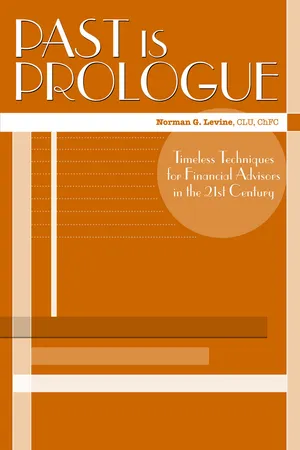![]()
Chapter 1
THE WAY IT WAS
Before I attempt to share my perception of “The way it was,” I would like to define the time frame about which we will reminisce.
Let me start by sharing with you a letter I received from a friend of over 50 years, Tom Wolff (an industry legend). On the occasion of my birthday he sent a beautiful letter sharing many thoughts. One in particular was a reference back to the “Golden Years.” He suggested that the last century, particularly in the 50’s, 60’s and 70’s, he had always remembered as the Golden Years. They were the most fun and had the greatest impact on his and my development.
He mentioned that it was interesting that his children, as well as my children, both followed us into the financial service business. And regrettably, will never know the wonders of those magic, Golden Years.
He went on to suggest that perhaps that’s a good thing because if they knew what he and I remember they might not enjoy their current careers as much as they all do.
All that notwithstanding, though I completely understand and agree with Tom, I will share in this chapter much of what I remember of how the business was, then in the next chapter, discuss the way it now is, and in the following chapter, though many changes are for the better, I will share some of the great pleasures and techniques of the Golden Years that have been lost along the way. For example, we have lost some of the excitement and motivation, along with skills and techniques, which if relearned and implemented in today’s world would certainly contribute to a more fulfilling career experience. They would also surely improve advisor productivity, while also better serving the client, and incidentally the advisor would also be having more fun.
Those Golden Years cannot be identified with a snapshot of any one particular year. My observations will include, from personal experience, the 40’s, 50’s, 60’s and part of the 70’s, but will also include the pre-World War II era as it was described to me by my early mentors and heroes.
Actually from the turn of the 20th century and well into the 60’s the financial service business changed very little. It was essentially much the same until the late 60’s when slowly change began to impact the industry, and then with an accelerating pace in the 70’s and 80’s, the new world was born. By the 90’s and the start of the 21st century, it was in some ways a different industry.
Let me also share a disclaimer of sorts, since I came into the business as an insurance salesman who did both Property and Casualty and Life Insurance business concurrently for the first seven years of my career and then became a full-time, exclusive Life Insurance agent in 1955. My initial impressions were through the eyes of an insurance salesperson. Therefore, though I will try to be objective about all the different components that today make up the financial service business, there might be some slightly distorted perspectives because of my own personal career experience. However, I am convinced the overview is essentially correct.
In those early years, financial services were in fact a group of super specializations with each segment exclusively representing its own product lines. Though we practiced our own particular specialties, we were exposed in competition to the other specialties but, in most instances, were only licensed to sell our specific products.
Beginning with the banking industry is a perfect example. Banks and savings banks were classically housed in very impressive structures with multiple customer windows, often with bars separating the teller (bank clerk) from the customer, and all business was transacted through those windows and at arms length. Basically, all the banks did was take, hold, and secure money. They had Trust Departments that targeted the very wealthy and for all intents and purposes no other products.
Savings banks in New York and Massachusetts were allowed to manufacture and distribute savings bank life insurance but with very severe limitations. The amount of insurance, the variety of insurance, and their allowable markets were restricted by regulation. Some insurance industry activists were concerned with banks becoming far more aggressive in the insurance field and the limits being significantly expanded. But that never happened.
The market for the professional proactive life insurance agent rarely conflicted with the relatively weak marketing expertise of a bank representative. As a matter of fact, having a little savings bank life insurance helped build the foundation of a portfolio upon which a qualified life insurance agent could superimpose a significantly more comprehensive and larger overall plan. I never personally felt the banks were a threat, and if anything, they helped me develop credibility and larger sales with my clientele. It is interesting that many life insurance activists were concerned with the development of financial products by any institution, other than a traditional life insurance company, even the Federal Government.
For example, when Social Security came into being some life insurance prophets of doom predicted that would be the end of the insurance industry. In actual practice, it was the catalyst that significantly expanded the life insurance segment of the financial service community and upon which large and significant financial plans were eventually superimposed. Social Security was a catalyst in educating the public to their own financial responsibility and it prepared a foundation upon which total financial plans could be built. So both banks and the Government, with their very specific and limited product lines, had a very positive effect on the development of life insurance careers.
However, banks were aware of the potential profit in other financial sales opportunities so they did try, through changes in regulation and legislation, to expand their portfolio of products. In broad terms, and for several decades they were generally, relatively ineffective.
I attended a meeting of bankers during the year when things were just beginning to change, and one of them reported that they had set up a desk in their banking facility for, in effect, comprehensive financial advising including insurance products, and the bank reported that the question their financial advisor specialist was asked most frequently was “Where is the restroom?”
Also, the government was somewhat concerned with the information banks had accumulated on their depositors. There was a fear that they were in position, theoretically, to pressure their account holders who were interested in borrowing money or getting a better rate of interest, to do other than banking business with the bank in order to benefit from some very favorable banking deals. As a result, the banks were restrained by regulation and legislation from aggressively diversifying during a good part of the last century. Besides the regulatory limitations however, bank executives and most certainly bank tellers, were unskilled and uneducated to be successful proactive financial advisors. In my opinion they never, in the 20th century, developed as significant competitors to the rest of the financial service world, but did a very good job in expanding and improving banking services.
Real estate salespeople were few and far between and mortgage brokers were non-existent. Prior to World War II, real estate brokers handled home or commercial sales and usually had direct arrangements with banks or lending institutions for financing. There was a tremendous change after World War II with millions of G.I.’s coming back from overseas service, getting married and having children, which resulted in the so-called baby-boomer generation. Housing was at a premium. Builders all over the country began tract-type housing at remarkably low cost.
The classic example in the 40’s was a builder by the name of Levitt. He built, in the suburban area of New York City, what was then known as Levittown. The houses in Levittown were quite comfortable with at least two bedrooms and a small piece of land. The houses all looked alike but, they were available for as little as $7,500 a house. This was an extraordinary development, I believe, involving thousands of homes. At the same time smaller tract housing developments were popping up coast to coast. My first stand-alone home cost approximately $12,000 and was one of 35 houses also in a suburban area of New York City. This was perceived by my friends as an upscale home. I had three bedrooms and two baths on a 60’ by 100’ lot with a backyard area, which I gardened, and a neat little front lawn. It had an attached garage, and although there were several models in our development to choose from, they were not very different than thousands and thousands of similar homes all over the United States.
The developers marketed the houses themselves and arranged for mortgages directly with pre-arranged lenders. As I said, at that time, independent real estate salesmen were very unusual and there were no mortgage brokers soliciting mortgage loans. Since the houses in these communities were usually purchased by returning veterans, recently married, and just starting families, each community was also the hub of the social life of friends and neighbors all experiencing a new lifestyle at the same time. Sharing and caring was the name of the game. You borrowed things from your neighbors. The wives, most of whom were not yet working, would get together for coffee klatches during the day while the men went off to work and the babies grew up in a very happy, sharing environment. Since these homes were all in suburbia, everyone had at least one car and the values and traditions of our parents and grandparents were maintained and perpetuated.
All those houses appreciated along with the inflationary impact on the entire economy, and as the returning veterans improved their economic position, they either significantly upgraded their homes or sold their first home and used it as the deposit for a more impressive second home. By then, real estate agents were becoming visible but the environment stayed pretty constant until the 60’s. The children of the Baby-Boomers began to kick up their heels, perhaps because of the Vietnam War, perhaps as a protest against society. Sharing and caring was replaced by “What’s in it for me?” and anti-establishment and anti-government movements began to proliferate among the younger generation. Drugs became much more available and abused and the traditions of marriage were being substantially moderated.
Though at first blush it might seem out of context to discuss this part of society in a chapter dedicated to the ‘way it was’ in the financial service business, there is no question that as society changed it had a tremendous impact on all of the financial institutions. As you will read in the next chapter, similar type changes were occurring in the varied financial institutions.
During those Golden Years, the investment business was relatively straightforward. It was primarily built on stocks and bonds purchased through stock brokers. My first job after graduating from high school, beginning college, and waiting to enter the military service in World War II, was with a stock brokerage firm, H. Hentz & Co., in the financial district in New York City. I was a boardroom runner. The salary was $14 a week; which really wasn’t bad for the time. World War II was already on and employers looking for older employees found it very limited so they took anyone they could get, even a young inexperienced person like myself.
The Boardroom consisted of rows of desks facing a projected-stock ticker tape and at each desk a stockbroker sat with a telephone. There were no computers. My job was when they wanted a price quote, they would give me a slip of paper, and I ran it back to the cage where they then found out the current price, wrote it on a slip of paper, and I delivered it back to the broker. If a sale was consummated over the telephone, which was the way almost all the sales were in fact negotiated, I again took the order form on a piece of paper to the cage, and when the sale was completed, brought it back to the stockbroker.
Basically the only products the stockbrokers were selling were stocks and bonds. Just as it was in banking and real estate, stockbrokers were specialists. Mutual funds had not yet been developed, and all of the various other investment vehicles were not yet part of their portfolio. Little did I know, in a way, that was the beginning of my financial service career and I one day would be a broker doing the same kind of thing as part of a totally diversified portfolio.
Another glaring difference in that era was that almost all people in the financial service profession, whether in insurance, investments, or real estate, were men. Most women were not yet working, although many did during World War II to help with the war effort, but in the so-called professions, men represented almost 100% of the...


